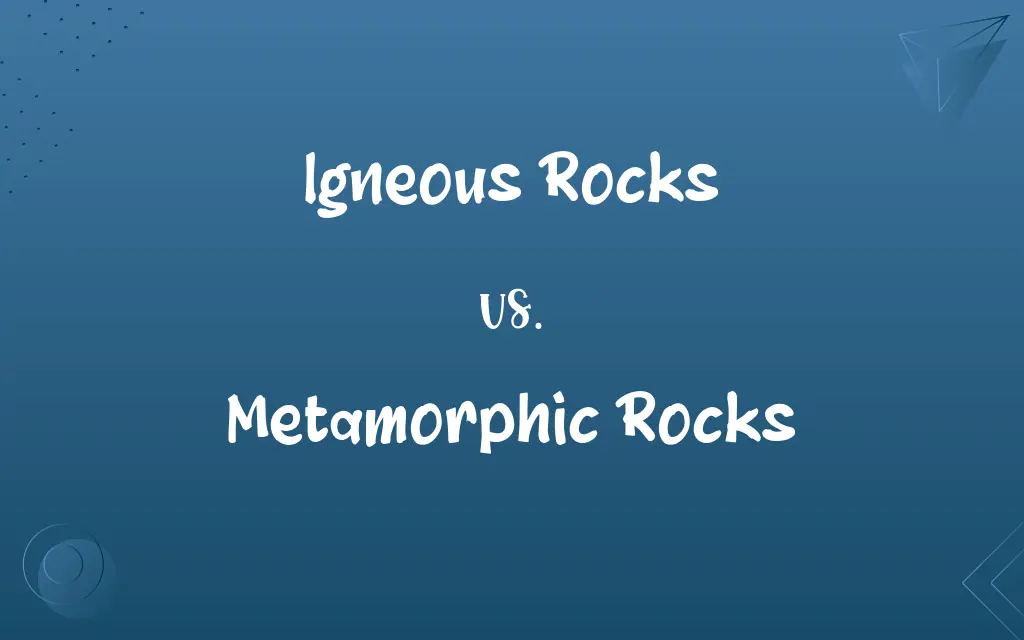Igneous Rocks vs. Metamorphic Rocks: Know the Difference

By Shumaila Saeed || Published on February 22, 2024
Igneous rocks form from cooled and solidified magma or lava, whereas metamorphic rocks are transformed by heat and pressure from existing rocks without melting.

Key Differences
Igneous rocks are formed from the solidification of magma or lava, either below or on the Earth's surface. Metamorphic rocks, however, originate from pre-existing rocks that undergo a transformation due to intense heat and pressure, deep within the Earth.
Shumaila Saeed
Feb 22, 2024
Igneous rocks can be fine-grained or coarse-grained, depending on their cooling rate, and are often rich in minerals like quartz and feldspar. Metamorphic rocks exhibit varied textures, including foliated layers, due to the alignment of minerals under pressure.
Shumaila Saeed
Feb 22, 2024
Common types of igneous rocks include granite and basalt. Metamorphic rocks include schist, gneiss, and marble, each with distinctive characteristics due to their formation process.
Shumaila Saeed
Feb 22, 2024
Igneous rocks tend to be hard and dense, with a crystalline structure. Metamorphic rocks can range from very hard, like quartzite, to relatively soft, like soapstone, depending on their mineral composition and the degree of metamorphism.
Shumaila Saeed
Feb 22, 2024
Igneous rocks are primary rocks that contribute to the Earth’s crust formation. Metamorphic rocks indicate past geological environments and processes, providing clues about the Earth's interior conditions.
Shumaila Saeed
Feb 22, 2024
ADVERTISEMENT
Comparison Chart
Syllables
Four syllables in “Igneous Rocks.”
Five syllables in “Metamorphic Rocks.”
Shumaila Saeed
Feb 22, 2024
Origin of Word
From Latin “ignis,” meaning fire.
From Greek “meta” (change) and “morph” (form).
Shumaila Saeed
Feb 22, 2024
Use in Compound Words
Examples include “igneous intrusion,” “igneous layer.”
Examples include “metamorphic zone,” “metamorphic grade.”
Shumaila Saeed
Feb 22, 2024
Pronunciation
Pronounced as /ɪgˈniːəs rɑks/ in American English.
Pronounced as /ˌmɛtəˈmɔrfɪk rɑks/ in American English.
Shumaila Saeed
Feb 22, 2024
ADVERTISEMENT
Igneous Rocks and Metamorphic Rocks Definitions
Igneous Rocks
Igneous rocks are characterized by a crystalline structure.
The igneous rock sample showed clear crystal formations.
Shumaila Saeed
Jan 16, 2024
Metamorphic Rocks
Rocks that indicate the conditions of the Earth's interior.
The presence of metamorphic rocks suggests past geological activity.
Shumaila Saeed
Jan 16, 2024
Igneous Rocks
A primary type of rock in the Earth's crust.
Granite, an igneous rock, is commonly used for countertops.
Shumaila Saeed
Jan 16, 2024
Metamorphic Rocks
Metamorphic rocks can be formed from igneous, sedimentary, or other metamorphic rocks.
Slate, a metamorphic rock, forms from shale under low-grade metamorphism.
Shumaila Saeed
Jan 16, 2024
Igneous Rocks
Rocks categorized into intrusive and extrusive types.
Obsidian is an extrusive igneous rock with a glassy texture.
Shumaila Saeed
Jan 16, 2024
ADVERTISEMENT
Metamorphic Rocks
Rocks formed from existing rock types altered by heat and pressure.
Marble is a metamorphic rock that started as limestone.
Shumaila Saeed
Jan 16, 2024
Igneous Rocks
Rocks formed by the cooling and solidification of magma or lava.
Basalt is an igneous rock that forms from lava flows.
Shumaila Saeed
Jan 16, 2024
Metamorphic Rocks
Exhibits foliated or non-foliated textures based on mineral alignment.
Schist, a metamorphic rock, is known for its foliated texture.
Shumaila Saeed
Jan 16, 2024
Igneous Rocks
These rocks often contain minerals like quartz and feldspar.
The igneous rock had a high quartz content.
Shumaila Saeed
Jan 16, 2024
Metamorphic Rocks
Common metamorphic rocks include slate, gneiss, and quartzite.
Gneiss is a metamorphic rock with distinct banding patterns.
Shumaila Saeed
Jan 16, 2024
Repeatedly Asked Queries
What causes rock to metamorphose?
Extreme heat, pressure, or chemically active fluids.
Shumaila Saeed
Feb 22, 2024
How are metamorphic rocks created?
Through heat and pressure altering existing rocks.
Shumaila Saeed
Feb 22, 2024
What is the cooling rate of igneous rocks?
Varies; slow underground, quick on surface.
Shumaila Saeed
Feb 22, 2024
Where do igneous rocks commonly form?
At volcanic sites and deep underground.
Shumaila Saeed
Feb 22, 2024
How do igneous rocks reach Earth's surface?
Through volcanic eruptions or uplift.
Shumaila Saeed
Feb 22, 2024
Can metamorphic rocks form from sedimentary?
Yes, through intense heat and pressure.
Shumaila Saeed
Feb 22, 2024
What textures do metamorphic rocks have?
Foliated or non-foliated textures.
Shumaila Saeed
Feb 22, 2024
Are all metamorphic rocks the same?
No, they vary based on their original form and metamorphic conditions.
Shumaila Saeed
Feb 22, 2024
Share this page
Link for your blog / website
HTML
Link to share via messenger
About Author
Written by
Shumaila SaeedShumaila Saeed, an expert content creator with 6 years of experience, specializes in distilling complex topics into easily digestible comparisons, shining a light on the nuances that both inform and educate readers with clarity and accuracy.








































































